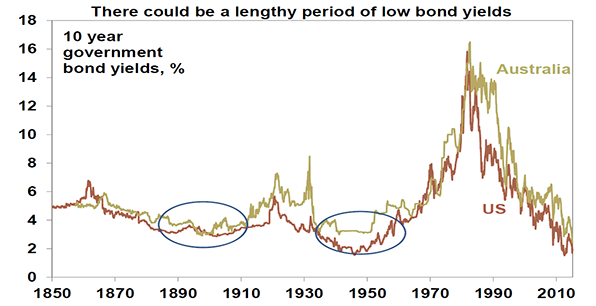Why Are Yields on ShortTerm Bonds So Low
Post on: 4 Октябрь, 2015 No Comment

Getty Images
Yields on U.S. Treasuries and short-term bonds have fallen to extremely low levels in recent years, punishing those who are investing for income. But why are interest rates so low, and is there hope that they will recover anytime soon?
U.S. Federal Reserve Policy Drives Down Rates
The reason for the low-rate environment investors face today is the zero interest rate policy of the U.S. Federal Reserve (“the Fed”). In the wake of the financial crisis of 2008, the Fed was forced to cut the federal funds rate to the ultra-low range of 0-0.25%. The fed funds rate is the rate at which banks lends to other institutions overnight.
The Fed has set rates at this ultra-low level in order to stimulate growth and help rescue the nation’s banking system. The theory behind this policy is that loan growth helps promote economic activity by making it less expensive to finance projects, home buying, car loans, and the like. Reducing the cost of loans, in turn, should help stimulate this type of economic activity and bring the country out of the post-crisis slowdown. The Fed’s low-rate policy also helps banks make more money by allowing them to earn a higher margin between the rate at which they borrow and the rate at which they lend. This was no small consideration coming out of the financial crisis, when many banks were on the verge of failure.
Why Does Fed Policy Affect Individual Investors?
The rate at which banks lend balances to one another is the most important driver of all other interest rates. It affects the rates banks pay on checking and savings accounts and certificates of deposit (CDs), and it also affects the prime rate, which in turn influences what consumers pay for home loans, car loans, and credit cards. In this way, low rates punish savers but help those that need to borrow.
Short-term bonds are also directly affected due to the nature of the yield curve. which is the graph that represents the yields that are available at each maturity (three months, six months, one year, etc.). Think of the fed funds rate as the first spot on the graph, in the lower left hand corner. With this rate pinned at zero, all other short-term rates are dragged lower across the “curve”. This is why savings bonds and Treasury bills offer yields less than 1%. Short-term Treasury rates form the basis for corporations’ short-term money market securities, which is why money market funds are also paying next to nothing.
The fed funds rate has less of an influence on longer-term bonds. For bonds with maturities of five years and higher, inflation expectations – and expectations of where the fed funds rate will go in the future – are the primary drivers of performance. Also, longer-term bonds can benefit when investors become frightened and stage a “flight to quality .” Still, the low fed funds rate — together with the Fed’s policies known as quantitative easing and Operation Twist — has helped depress yields for bonds of all maturities .
When Will Rates Go Up Again?
While the U.S. financial crisis is now in the past, the Fed is maintaining its low-rate policy to help cope with a continued environment of sluggish economic growth and elevated unemployment. The Fed has stated its intention to keep rates at zero at least through the middle of 2015. As a result, investors will continue to bear the brunt of the Fed’s low-rate policy.
Fortunately, there are a number of options to earn higher yields. While riskier – and in some case, much riskier – than bank accounts or short-term government bonds, other asset classes investors can consider for higher income include:
Disclaimer. The information on this site is provided for discussion purposes only, and should not be construed as investment advice. Under no circumstances does this information represent a recommendation to buy or sell securities. Always research carefully before you invest.














